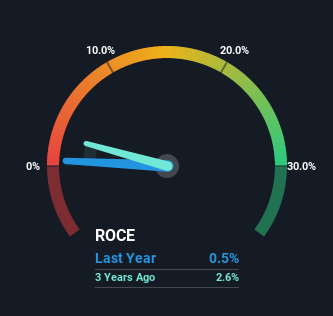IPE Group's (HKG:929) Returns On Capital Not Reflecting Well On The Business

Ignoring the stock price of a company, what are the underlying trends that tell us a business is past the growth phase? Businesses in decline often have two underlying trends, firstly, a declining return on capital employed (ROCE) and a declining base of capital employed. This combination can tell you that not only is the company investing less, it's earning less on what it does invest. On that note, looking into IPE Group (HKG:929), we weren't too upbeat about how things were going.
What Is Return On Capital Employed (ROCE)?
For those that aren't sure what ROCE is, it measures the amount of pre-tax profits a company can generate from the capital employed in its business. Analysts use this formula to calculate it for IPE Group:
Return on Capital Employed = Earnings Before Interest and Tax (EBIT) ÷ (Total Assets - Current Liabilities)
0.0048 = HK$10.0m ÷ (HK$2.3b - HK$249m) (Based on the trailing twelve months to December 2022).
Therefore, IPE Group has an ROCE of 0.5%. In absolute terms, that's a low return and it also under-performs the Machinery industry average of 7.3%.
See our latest analysis for IPE Group

Historical performance is a great place to start when researching a stock so above you can see the gauge for IPE Group's ROCE against it's prior returns. If you want to delve into the historical earnings, revenue and cash flow of IPE Group, check out these free graphs here.
SWOT Analysis for IPE Group
- Debt is well covered by earnings.
- Earnings declined over the past year.
- 929's financial characteristics indicate limited near-term opportunities for shareholders.
- Lack of analyst coverage makes it difficult to determine 929's earnings prospects.
- Debt is not well covered by operating cash flow.
So How Is IPE Group's ROCE Trending?
In terms of IPE Group's historical ROCE movements, the trend doesn't inspire confidence. To be more specific, the ROCE was 7.5% five years ago, but since then it has dropped noticeably. And on the capital employed front, the business is utilizing roughly the same amount of capital as it was back then. This combination can be indicative of a mature business that still has areas to deploy capital, but the returns received aren't as high due potentially to new competition or smaller margins. So because these trends aren't typically conducive to creating a multi-bagger, we wouldn't hold our breath on IPE Group becoming one if things continue as they have.
What We Can Learn From IPE Group's ROCE
In summary, it's unfortunate that IPE Group is generating lower returns from the same amount of capital. It should come as no surprise then that the stock has fallen 64% over the last five years, so it looks like investors are recognizing these changes. Unless there is a shift to a more positive trajectory in these metrics, we would look elsewhere.
Since virtually every company faces some risks, it's worth knowing what they are, and we've spotted 4 warning signs for IPE Group (of which 1 is a bit unpleasant!) that you should know about.
While IPE Group isn't earning the highest return, check out this free list of companies that are earning high returns on equity with solid balance sheets.
New: AI Stock Screener & Alerts
Our new AI Stock Screener scans the market every day to uncover opportunities.
• Dividend Powerhouses (3%+ Yield)
• Undervalued Small Caps with Insider Buying
• High growth Tech and AI Companies
Or build your own from over 50 metrics.
Have feedback on this article? Concerned about the content? Get in touch with us directly. Alternatively, email editorial-team (at) simplywallst.com.
This article by Simply Wall St is general in nature. We provide commentary based on historical data and analyst forecasts only using an unbiased methodology and our articles are not intended to be financial advice. It does not constitute a recommendation to buy or sell any stock, and does not take account of your objectives, or your financial situation. We aim to bring you long-term focused analysis driven by fundamental data. Note that our analysis may not factor in the latest price-sensitive company announcements or qualitative material. Simply Wall St has no position in any stocks mentioned.
About SEHK:929
IPE Group
An investment holding company, engages in the manufacture and sale of precision metal components and assembled parts for use in automotive parts, hydraulic equipment, electronic equipment component, and other devices.
Flawless balance sheet with acceptable track record.
Market Insights
Community Narratives



